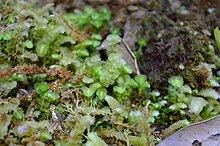| Acrobolbus pseudosaccatus | |
|---|---|

| |
| Scientific classification | |
| Kingdom: | Plantae |
| Division: | Marchantiophyta |
| Class: | Jungermanniopsida |
| Order: | Jungermanniales |
| Family: | Acrobolbaceae |
| Genus: | Acrobolbus |
| Species: | A. pseudosaccatus |
| Binomial name | |
| Acrobolbus pseudosaccatus (Grolle) Briscoe | |
| Synonyms | |
| |
Acrobolbus pseudosaccatus, synonym Tylimanthus pseudosaccatus, is a bryophyte, a species from the liverwort family Acrobolbaceae. The family grows on logs, rocks, and soil. Under certain circumstances, however, they are epiphyte, growing on other plant species.
Description
The leaves of Acrobolbus pseudosaccatus have a shallow depression at the tip, and the margin is finely toothed. The leaves are very fine and are translucent green. Plants are also robust in size. The finely toothed margins distinguish TylimaAcrobolbusnthus pseudosaccatus from other members in the Acrobolbaceae family. The most distinctive feature, however, is the reproductive structure. The position of the reproductive structures most accurately distinguishes Acrobolbus pseudosaccatus from any other species. The sporophyte (reproductive structure) develops in a pouch at the shoot apex structure.
Taxonomy
The species was first described in 1963, as Tylimanthus pseudosaccatus. The genus Tylimanthus was later synonymized with Acrobolbus, and Tylimanthus pseudosaccatus was transferred as Acrobolbus pseudosaccatus in 2015.
Distribution and habitat
Acrobolbus pseudosaccatus is located in the Southern Hemisphere, found in Australia. They are endemic to south-east Australia in New South Wales, Victoria, and Tasmania. Their habitat requirement consists of environments which retain moisture. Mostly in forests, wet sclerophyll forests or they could also be found in rainforests. The liverworts are found in environments which are either middle-aged or old-growth forests, as these provide the bryophytes with protection.
Liverworts are significant in their habitats as their presence in an environment offers microhabitats. The importance of the microhabitats is that it creates an environment which is essential for the survival of other organisms. These organisms include protozoa, invertebrates, and eukaryotes. The reasoning for why they create important microhabitats is due to bryophytes been nitrogen fixers. Other organisms depend on nitrogen as it allows for those species to grow and develop, overall improving the quality of the soil.
References
- ^ "Acrobolbus pseudosaccatus (Grolle) Briscoe". Global Biodiversity Information Facility. Retrieved 2024-04-11.
- ^ Jarman, S.J. & Fuhrer, B.A., Mosses and liverworts of rainforests in Tasmania and south-eastern Australia. CSIRO and Forestry Tasmania, 1995
- https://www.utas.edu.au/dicotkey/dicotkey/Lworts/ACROBOLBACEAE/sTylim_pseudo.htm. Key to Tasmanian vascular plants, Jordan, G., 2019, University of Tasmania, Accessed October 29th 2019
- Briscoe, L., Engel, J.J., Soderstrom, L., Hagborg, A. & Von Konat, M.,Notes on early land plants today. 66. nomenclatural notes on Acrobolbaceae. Phytotaxa, 2015, p.58-62
- ^ Brinda, John C. & Atwood, John J., eds. (2024). "Tylimanthus pseudosaccatus". The Bryophyte Nomenclator. Retrieved 2024-04-11.
- "Acrobolbus Nees". Global Biodiversity Information Facility. Retrieved 2024-04-11.
- Briscoe, L.; Engel, J.; Söderström, L.; Hagborg, A. & Von Konrat, M. (2015). "Notes on early land plants today. 66. Nomenclatural notes on Acrobolbaceae". Phytotaxa. 202 (1): 58–62. doi:10.11646/phytotaxa.202.1.8.
- https://www.anbg.gov.au/abrs/liverwortlist/liverworts_a_z.html, Checklist of Australian liverworts and hornworts, Accessed October 29th 2019
- Tng, D.Y.P., Dalton, P.J. & Jordan, G.J.,Does moisture affect the partitioning of bryophytes between terrestrial and epiphytic substrates within cool temperate rain forest?, The Bryologist, 2009, 112: p.506-519
- Turner, P.A.M., Kirkpatrick, J.B. & Pharo, E.J. Dependence of bryophyte species on young, mature and old growth wet eucalypt forest Biological Conservation, 2011, p. 2951-2957
- Hodge, D.A, Pharo, E.J., Dalton, P.J. & Turner, P.A.M.,Successional patterns of terrestrial bryophytes along wildfire chronosequence in wet eucalypt forests of southern Tasmania. Tasforests, 2009, p.67-76
- ^ Gerson, U., Bryophytes and invertebrates. Bryophyte Ecology, 1982, p.291-332
- Soderstrom, L., Hagborg, A., Von Konrat, M., Bartholomew-Began, S., Bell, D., Briscoe, L., Brown, E., Cargill, C., Da Costa, D.P., Crandall-Stoter, B.J., Cooper, E.D., Dauphin, G., Engel, J., Feldberg, K., Glenny, D,. Gradstein, He, X., Heinrich, J., Hentschel, J., Ilkiu-Borges, A.L., Katagiri, T., Konstantinova, N.A., Larrain, J., Long, D., Nebel, M., Pocs, T., Puche, F,. Reiner-Drehwald, E., Renner, M., Sass-Gyarmati, A., Schäfer-Verwimp, A., Segarra-Moragues, J.G., Stotler, R.E., Sukkharak, P., Theirs, B., Uribe, J., Vana, J., Villarreal, J., Wigginton, M., Zhang, L. & Zhu, R.,World checklist of hornworts and liverworts. PhytoKeys, 2016, 59, p.1-828
Further reading
- Kantvilas G and Jarman SJ. 2012. Lichens and bryophytes in Tasmanian wet eucalypt forest: floristics, conservation and ecology. Phytotaxa 59: 1-31.
| Taxon identifiers | |
|---|---|
| Acrobolbus pseudosaccatus | |
| Tylimanthus pseudosaccatus | |